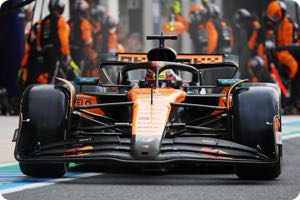MAY 12, 2025
Secret of McLaren trick may now have emerged
A Formula 1 expert thinks he might have discovered the secret of McLaren's field-leading advantage in tyre performance in 2025.
On their worst days, they're still the best,
said Mercedes' George Russell, when asked about how quickly the McLarens get the tyres up to temperature and then suffer minimal degradation through a long stint.
It all points to nine teams doing something wrong,
he added.
It is Red Bull, however, that is leading the dissent over McLaren's tyre dominance, suggesting behind the scenes that the team might even be injecting water into the Pirellis.
McLaren CEO Zak Brown poked fun at the theory with his 'Tyre Water'-marked water bottle in Miami, and even FIA president Mohammed Ben Sulayem warned Red Bull against lodging a frivolous protest.
I agree with Zak that if you lodge a protest, the cost should come out of your cost cap, and you only get it back if you're proven right,
he said.
Pirelli's F1 boss Mario Isola also dismissed the 'tyre water' theory.
We monitor tyre pressure and temperatures constantly through sensors,
he said. "Forcing water through the valve or any part of the tyre would be immediately visible in the data.
It's not just highly unlikely, it's almost impossible under the current FIA monitoring system.
However, a fascinating new theory has emerged, as described in detail in Germany's Auto Motor und Sport.
Journalist Michael Schmidt notes that last year, Red Bull complained that the McLarens were using temperature sensors on the brakes outside of free practice sessions.
It's also notable,
he said, that McLaren often do aggressive long runs in FP3, leaving the competition far behind. Perhaps they're trying to find something out under extreme conditions.
What might McLaren be checking? Schmidt revealed that he has heard that McLaren could be using special 'phase change materials' (PCM) in the components surrounding the brakes.
PCMs are able to store and release thermal energy during a phase transition from solid to liquid. That could explain Red Bull's observation that moisture can sometimes be seen coming from the inside of the McLaren wheel rims.
Perhaps fluid was sweating out during the phase transition,
Schmidt hypothesised.
Admittedly, it all sounds a little other-worldly, but it's at least plausible - and there's some evidence to support this. For example, Red Bull's disruptive tactic about the water in the tyres.
Schmidt continued: But even if McLaren's rivals already know exactly what McLaren is doing, it's not that easy to copy the trick.
He even speculates that Red Bull might already be experimenting with similar materials, which could explain Max Verstappen's recent repeated complaints about brake performance.
When asked whether this was related to tyre cooling, team boss Christian Horner gave only monosyllabic answers,
Schmidt concluded.
(GMM)
